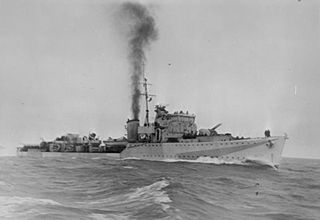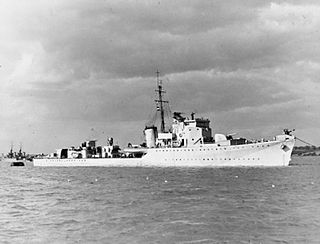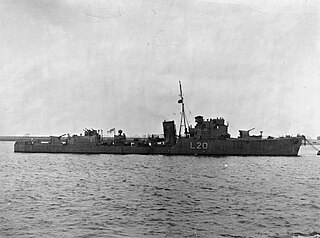
HMS Quorn was a Hunt-class destroyer of the Royal Navy, built in 1940 and sunk off the Normandy coast on 3 August 1944. The class were named after British fox and stag hunts, in this case, the Quorn Hunt, predominantly based in Leicestershire.

HMS Whaddon (L45) was a Type I Hunt-class destroyer of the Royal Navy built by Alexander Stephen & Sons of Linthouse, Govan and launched on 16 July 1940. She was laid down on 27 July 1939 and commissioned 28 February 1941. She was adopted by the civil community of Newport Pagnell in Buckinghamshire, as part of the Warship Week campaign in 1942.

HMS Mendip (L60) was a Hunt-class destroyer of the Royal Navy. She was a member of the first subgroup of the class. The ship is notable for seeing service in the navies of three other nations after her use by the Royal Navy. She saw service in the Second World War and later as an Egyptian Navy ship in the Suez Crisis. She was captured in battle on 31 October 1956 by the Israeli Navy and re-commissioned as INS Haifa (K-38).

HMS Brecon was a Hunt-class destroyer of the Royal Navy that saw service in the Second World War, one of two ships in the fourth subgroup of the class, built to a radically different design from other ships in the Hunt class.

HMS Wheatland was a Type 2 Hunt-class destroyer of the Royal Navy that served in the Second World War.

The second HMS Hambledon was a Hunt-class destroyer of the Royal Navy in commission from 1940 to 1945. She was a member of the first subgroup of the class, and saw service throughout World War II.
HMS Blencathra (L24) was a Hunt-class destroyer of the Royal Navy in commission from 1940 to 1948. She was a member of the first subgroup of the class, and saw service through most of World War II.

HMS Versatile (D32) was an Admiralty V-class destroyer of the British Royal Navy that saw service in World War I, the Russian Civil War, and World War II.

The third HMS Windsor (D42) was a W-class destroyer of the British Royal Navy that saw service in the final months of World War I and in World War II.

HMS Brocklesby was a Type I Hunt-class destroyer of the Royal Navy. She served during the Second World War, spending much of the time in the English Channel and Mediterranean, taking part in the Dieppe Raid in 1942, and the Allied landings in Sicily and at Salerno in 1943. After the war, she was used as a sonar trials ship until 1963, and was sold for scrap in 1968.

HMS Berkeley was a Type I Hunt-class destroyer of the Royal Navy. She was a member of the first subgroup of the Hunt class and saw service in World War II before being bombed at Dieppe and then scuttled by HMS Albrighton.

HMS Cattistock (L35) was a Type I Hunt-class destroyer of the Royal Navy. She was a member of the first subgroup of the Hunt class and served throughout World War II before being scrapped in 1957.

HMS Meynell was a Type I Hunt-class destroyer of the Royal Navy which served in World War II. She was sold to Ecuador in 1954 where she served as Presidente Velasco Ibarra.

HMS Garth was a Type I Hunt-class destroyer of the Royal Navy built by John Brown & Company on the River Clyde, and launched on 28 December 1939. She was adopted by the Civil Community of Wokingham, Berkshire, as part of the Warship Week campaign in 1942.

HMS Holderness was a Type I Hunt-class destroyer of the Royal Navy which served in World War II. She was scrapped in 1956.

HMS Cotswold was a Type I Hunt-class destroyer of the Royal Navy which served in World War II. She was scrapped in 1957.

HMS Cowdray was a Type II Hunt-class destroyer of the Royal Navy which served in World War II. She has been the only Royal Navy ship to bear the name. She was scrapped in 1959.

HMS Wilton was a Type 2 Hunt-class destroyer of the Royal Navy that served in the Second World War.

HMS Lauderdale was a Hunt-class destroyer of the Royal Navy. Ships of this class were designed as cheap, easily built vessels for convoy escort and antisubmarine duties. She was named like her sisters after a fox hunt, in her case one in Berwickshire. War bonds were issued to finance the building of warships. During Warship Week held in 1942 the civil community of Berwickshire adopted the ship. She has been the only Royal Navy warship to carry this name.

HMS Belvoir was a Hunt-class destroyer of the Royal Navy. She was a member of the third subgroup of the class, and saw service in the Second World War. She was adopted by the civil community of Sutton in Ashfield, Nottinghamshire during Warship Week in 1942.


















